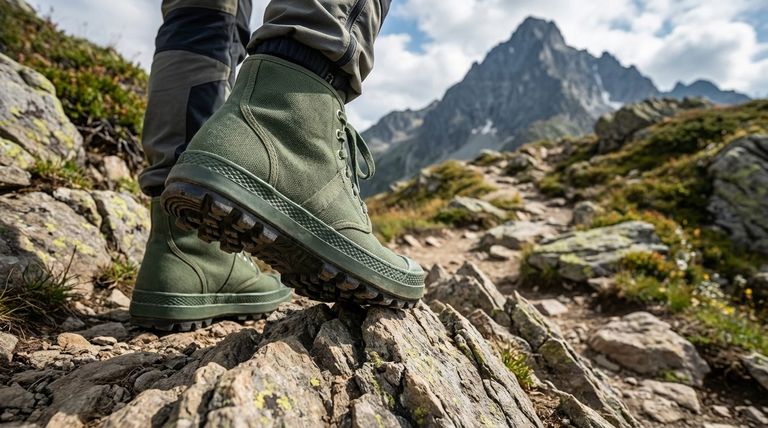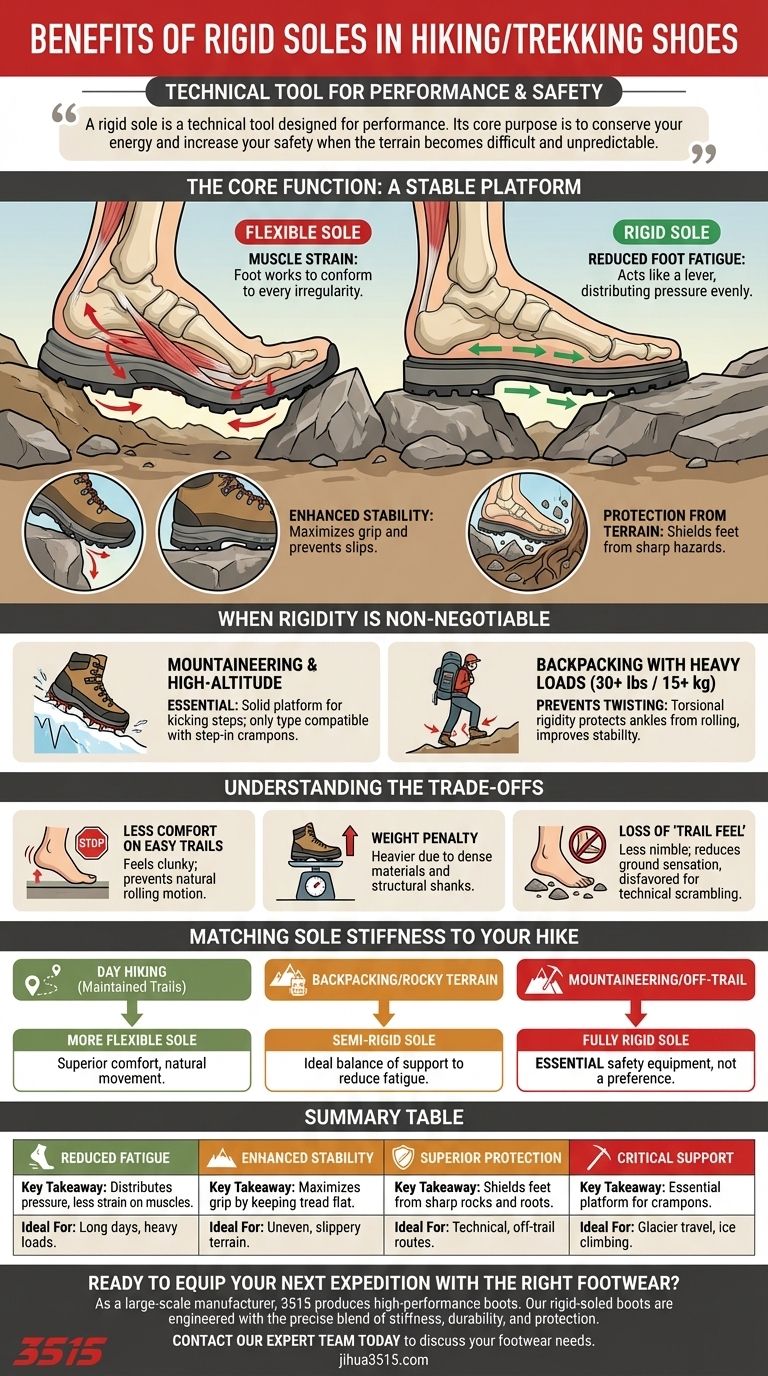The primary benefit of a rigid sole is its ability to create a stable, protective platform for your foot on demanding terrain. This stiffness directly translates to less foot fatigue, enhanced stability on uneven ground, and better protection from sharp rocks, making it essential for mountaineering, backpacking with heavy loads, and navigating challenging off-trail routes.
While a flexible shoe feels comfortable on a flat path, a rigid sole is a technical tool designed for performance. Its core purpose is to conserve your energy and increase your safety when the terrain becomes difficult and unpredictable.

The Core Function: A Stable Platform
The true value of a rigid sole becomes clear when you understand the physics of hiking on rough ground. Your foot is no longer just walking; it's constantly adapting, balancing, and pushing off of unstable surfaces.
Reducing Foot Fatigue
A stiff sole acts like a lever, distributing pressure evenly across your entire foot. Instead of your foot muscles working to conform to every rock and root, the sole bridges these irregularities.
This significantly reduces the muscular strain on the arches and tendons of your feet over a long day, especially when carrying the extra weight of a backpack.
Enhancing Stability and Grip
A rigid platform ensures the shoe's outsole and its lugs maintain their optimal shape for traction.
A flexible shoe can bend and deform on a rock edge, reducing the surface area of the lugs that are in contact with the ground. A rigid sole keeps the tread flat, maximizing grip and preventing slips.
Protection from Terrain
The most straightforward benefit is protection. The stiffness prevents sharp rocks, roots, or other trail hazards from bruising the bottom of your foot. This protective quality is a critical component of safety and comfort in rugged environments.
When Rigidity is Non-Negotiable
While not necessary for every hike, a stiff sole becomes a critical piece of safety equipment in certain scenarios.
Mountaineering and High-Altitude Hikes
For mountaineering, a fully rigid sole is essential. It provides the solid platform required to kick steps into hard snow and is the only type of sole compatible with step-in crampons for glacier travel or ice climbing.
Backpacking with Heavy Loads
When you carry a heavy pack (30+ lbs / 15+ kg), your center of gravity is higher and you are less stable. The torsional rigidity of a stiff sole prevents the shoe from twisting, which helps protect your ankles from rolling on uneven ground.
Understanding the Trade-offs
Choosing a rigid sole involves a clear set of compromises. Understanding them is key to selecting the right boot.
The Cost of Comfort on Easy Trails
On flat, well-maintained trails, a rigid sole can feel clunky and unnatural. It prevents the natural rolling motion of your foot, which can feel less comfortable and efficient on simple walks.
The Weight Penalty
Stiffness is achieved through the use of dense materials and structural components like shanks. As a result, boots with rigid soles are almost always heavier than their flexible counterparts.
Loss of "Trail Feel"
With a rigid sole, you lose much of the sensation of the ground beneath you. While this protects your feet, it can also make you feel less nimble, which some hikers dislike on technical, scrambly terrain where precise foot placement is key.
Matching Sole Stiffness to Your Hike
Ultimately, the right choice depends entirely on your intended use. Use this as your guide.
- If your primary focus is day hiking on maintained trails: A more flexible shoe will provide superior comfort and feel more natural for your foot's movement.
- If your primary focus is backpacking or hiking on very rocky, uneven terrain: A semi-rigid sole offers the ideal balance of support to reduce fatigue without being overly restrictive.
- If your primary focus is mountaineering or technical off-trail travel: A fully rigid sole is an essential piece of safety equipment, not a matter of preference.
Choosing the correct sole stiffness is about selecting the right tool for the job to maximize your performance, safety, and enjoyment on the trail.
Summary Table:
| Benefit | Key Takeaway | Ideal For |
|---|---|---|
| Reduced Fatigue | Distributes pressure, less strain on muscles. | Long days, heavy loads. |
| Enhanced Stability | Maximizes grip by keeping tread flat on rocks. | Uneven, slippery terrain. |
| Superior Protection | Shields feet from sharp rocks and roots. | Technical, off-trail routes. |
| Critical Support | Essential platform for crampons in mountaineering. | Glacier travel, ice climbing. |
Ready to equip your next expedition with the right footwear?
As a large-scale manufacturer, 3515 produces a comprehensive range of high-performance hiking and mountaineering boots for distributors, brand owners, and bulk clients. Our rigid-soled boots are engineered with the precise blend of stiffness, durability, and protection needed for the most demanding trails.
Let us help you provide your customers with the stability and safety they demand. Contact our expert team today to discuss your footwear needs and explore our production capabilities.
Visual Guide

Related Products
- Factory-Direct Wholesale Canvas Boots with High-Traction Rubber Soles
- Wholesale High-Traction Camo Boots - Custom Manufacturer for Brands
- High Performance Fire-Retardant Waterproof Safety Boots
- Premium Wholesale Waterproof Safety Boots High Performance Protection for Industrial Markets
- Premium Grain Leather Safety Boots for Bulk Supply
People Also Ask
- What is a vulcanized sole? Discover the Secret to Superior Flexibility and Grip
- What role do slip-resistant rubber materials play in safety shoes? Ensuring Grip and Stability in Hazardous Workplaces
- What should be avoided when storing boots with outsoles? Protect Your Investment from Dry Rot & Decay
- What are the advantages of rubber soles in safety boots? Unbeatable Grip & Durability
- Why are rubber soles beneficial in cold-weather boots? Superior Traction & Waterproofing



















